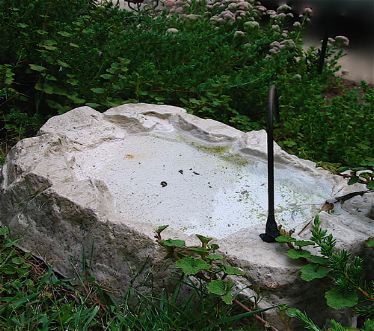-
Add a Birdbath for Wildlife Friendly Habitat
Our North Georgia yard is always fluttering with avian activity. Probably due to the many bird feeders and birdhouses, but positively because of the birdbaths and water features. For the last 30 days or so I think it has rained only once. Pastures and lawns are parched, and flowers that usually thrive well into fall have seen better days.
Two pedestal baths each have their own gizmo so there’s always moving water. One has a dripper, the other a water wiggler. Since this water always moves, it is a major attractor for birds, it works like a visual magnet! It’s also good to know that mosquitoes can not lay their eggs in these birdbaths.
This ground birdbath with an attached dripper has got to be by far the most popular spot. Of course everyone took off when I went to take the picture. There’s also a leaf mister staked in the ground nearby, which shares the same water connection via a T-connector in the rubber tubing. Butterflies, hummingbirds and most of the regulars frequent this spot daily. Some birds even crowd around to wait their turn for a dip in this great birdbath!
The landscaping helps too, lush and mature trees, shrubs and flowers, with perennials for butterflies like lantana, milkweed, and butterfly bush. A shepherd’s hook with three bird feeders is also close to this water feature. I guess if I were a bird, it would be a pretty decent spot to hang around!
-
Colors Are Changing at the Finch Bird Feeder
When one thinks of finches, it’s thistle or nyjer seed that usually comes to mind. This is a staple for finches, especially American Goldfinches. Here at this tube feeder, it seems goldfinches and a purple finch are chowing down on a standard seed mix. Both will feed on sunflower seed, and possibly some other goodies in the mix.
No matter what type of seed your finch bird feeder may be offering, you can count on the fact that mother nature takes her course regardless. Very soon, the vibrant yellow feathers we’ve seen all summer on sweet goldfinches will give way to a more olive-drab color. It’s the second molt of the season for goldfinches, when nature sheds the old tattered feathers and outfits birds with a new set to help brave the winter.
Cardinals are also going through the molting process now, and may appear a little scrawny or sickly-looking. Know that they’re healthy and just preparing to suit up in their vibrant red plumage.
The molting process of fall also signals the migration of many songbirds. Vireos, Warblers and more are on their way to southern wintering grounds. These birds need fuel and refreshments along the way in order to stay fat for the long journey. Placing suet out now is a great way to help migratory birds, with a high fat and protein snack that packs in the calories. Fresh water also helps migratory songbirds on their journey. A birdbath may serve as an oasis to some of these weary travelers. Keep an eye out for visitors to your yard…you never know who may stop by!
-
Crowded Thistle Feeders?
With tons of Goldfinches out and about now, thistle feeders are likely to be a very busy spot in your yard. Because Goldfinches are one of the latest breeding/nesting birds, many juveniles are now crowding thistle feeders and learning to eat on their own. One of the favorite songbirds who will winter-over if thistle (or nyjer) is offered on a consistent basis, Goldfinches will grace your garden all year. A heated birdbath is also another major attraction for these sweet birds to stick around.
With one of their two upcoming seasonal molts, vibrant yellow plumage will soon give way to a more olive-drab one. But as spring once again approaches, the electric yellow feathers will be seen through late summer and early fall.
The use of Thistle Socks or Thistle bags will help to alleviate crowds at your regular thistle feeders, and ensure that all babies get to eat. Fairly inexpensive and available from small to large, these mesh stockings provide an “all-over” eating area for finches and other birds who prefer thistle seed.
Cardinals are also molting right now, and although they might look a bit sickly…rest assured it’s just the process of shedding old worn feathers for vibrant new ones.





